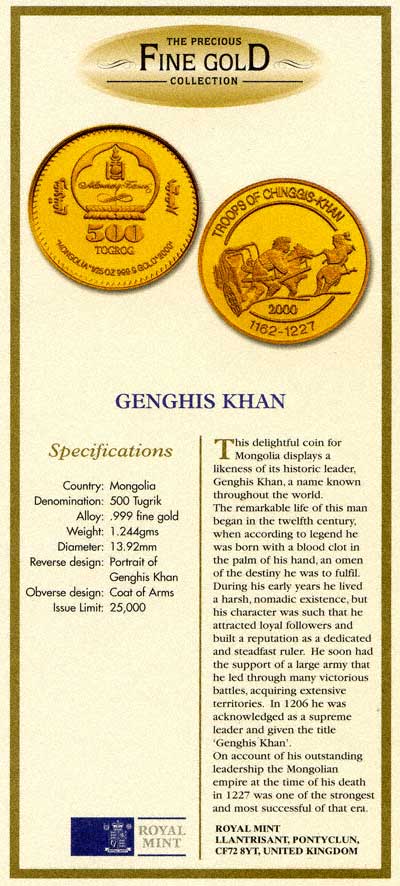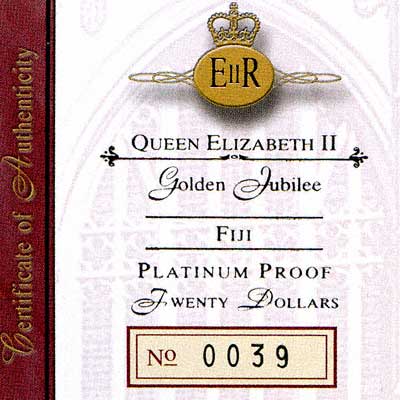Certificates for Proof Coins
Many proof coins are issued complete with some kind of presentation or display packaging, and a certificate. Sometimes the packaging costs more than the coin!
COA - C.O.A. - Certificate of Authenticity
The acronym, COA appears to have come into common use, particularly on internet auction sites, by which we actually mean eBay as it appears to have achieved world domination.
Perhaps it is easier for avid texters to type COA (or coa), or maybe it's because they aren't confident about spelling a long word like CERTIFICATE, or perhaps it's because of their busy lifestyle. I suppose we should not be too harsh on eBayers, for they know not what they do, and besides it's long bee useful to use abbreviations in adverts, and the title line of an auction should be as concise as possible, packing in all the most important information for any potential buyer.
Are Certificates Important?
Sadly we have to observe that in most cases, a certificate is important; more important than it really should be.
If you buy a proof gold sovereign, or any expensive coin set, and it comes complete with a certificate, it is almost always well worth keeping the certificate with the item itself, or at least in a safe place.
Why Are Certificates Important?
It's a marketing thing, really.
We do not know when the first mint starting supplying certificates with its collector coins, but if we look at the British Royal Mint, we can see that the proof gold sovereigns issued in 1979 were not issued with a certificate, however those issued from 1980 onwards were. We will try to get time to do a little research, and see what countries or mints started issuing certificates earlier. We do know that many medallists such as John Pinches used to issue certificates as early as 1965 when many gold medals were issued for Winston Churchill, and other worthy causes.
This still does not answer the question why. At some stage one of the mints must have realised that issuing a certificate with a coin gave an added feel-good factor to the buyer for very little extra cost. Many mints had been in the habit of including informative leaflets or booklets with their coins. Again using the British Royal Mint as an example, the "Last £.s.d." proof coin sets issued in 1970 came with a folded information sheet describing each coin, and giving a potted history. These leaflets did not include a certificate, but it would have only been a small step to incorporate one. We also presume that the mints observed that medallists including Franklin Mint issued their products with certificates.
Once it became routine for mints to include certificates with new products, then many collectors came to expect a certificate, and feel deprived if a new coin arrived without one.
In the secondary market, there are many proof coins still with their certificates, and others without them. It is fairly obvious that you might as well buy a coin with its certificate than without it, so that a certificate acquires some value of its own.
Branding & Confidence
The presence of a certificate can give a buyer or owner more confidence that the product he is buying is genuine, although if coins can be faked, then certificates must be even easier to fake. This boost to confidence will almost certainly be greater in an inexperienced or new collector than for an expert. An expert can be expected to be able to discern for himself that the coin is genuine, so for him the certificate is merely a bonus, whereas the less knowledgeable the collector, the more important the certificate becomes, until we reach the rather ridiculous point where a collector will not buy a coin without its certificate, at which point the certificate has become more important than the coin, and arguable more valuable. Perhaps one day, we will reach the stage where come collectors are only interested in the certificates, and don't want the coins at all!
If it seems that we are poking fun at those who can't live without their certificates, we would respond that we do respect the fact that everybody is different, and we all get our pleasure in slightly different ways. We enjoy observing our fellow humans, and this COA mania is quite intriguing, especially when you take it to its logical conclusion.
We believe branding is important when it comes to certificates. Most Royal Mint certificates are worth keeping even without their coins (we buy them!), but others would be more useful if they were printed on softer paper, preferably with perforations.
Brand Names & Value
One of the reasons why brand names are important is the knowledge, or reasonable expectation, that the product will be at least consistent, of known, and possibly high, quality. Most people would select a can of Heinz beans than a similar can with an unknown brand, and pay extra for the privilege. However the value in a brand name is a volatile commodity, and a reputation acquired over centuries can be spoiled by greed, negligence or other short-sighted behaviour. Pick up a Cadbury's chocolate bar, and remember that the makers think low levels of salmonella are quite acceptable. We believe our own Royal Mint takes risks with its image through some of its marketing, and when we publish our views, its management are not too happy with us, even though we are probably doing more to protect its image than they are.
How Much?
The monetary value of any certificate depends on a number of factors. These include:
- The value of the product it accompanies. A certificate with a high priced product will tend to be more valuable than one for a low priced one.
- The price premium of the product. If the product sells for a high premium over its intrinsic or face value, then the certificate will tend to have more value.
- Supply and demand. Not only that of the product itself, but the relative supply and demand for coins both with and without their certificates.
Examples
The 1989 proof sovereign is now a high premium coin. As we originally wrote this, its intrinsic gold content was less than £115, but its market value was around £600 to £700. As could be expected, with a high priced coin changing hands at 5 or 6 times its gold content, the presence or absence of a certificate becomes more important, although a possible better example is the lower priced 1999 sovereign. For some unknown reason, these tend to be harder to buy than some other lower mintage dates between 1990 and 1998. Some time ago, we were advertising to pay £200 for each for them, and we were offered 12 pieces by a fellow bullion dealer. Unfortunately, although they were perfect, and still in their capsules, they were without boxes and certificates. Most proof sovereign boxes are interchangeable, but certificates are not. We offered £150 each for the coins, not with great enthusiasm, and were soon their owner. We offered them for sale about £75 each below our price for the "complete" product, and it took some time to sell them. Even now, we would offer about £50 less for a 1999 proof sovereign without a certificate than we would complete.
We could contrast these examples with certificates from Westminster. We guess that Westminster save some money by buying some proof coins without Royal Mint boxes or certificates, and providing their own. We would always choose a Royal Mint certificate (and box), in preference to one from Westminster. There are other coin marketing companies who do similar to Westminster, and similar considerations would also apply to them. We have noticed a number of errors and inconsistencies on certificates, including the following:
Worth Its Weight in Gold?
Fast forwarding to July 2011, in a quiet moment we finally got round to something we had been meaning to do for ages, and that is weighing a certificate, specifically one for a 1989 proof sovereign. The one we weighed registered 1.14 grams. Let's assume that the absence or presence of a certificate would make a £50 difference; this works out at £43.86 per gram, or £1,364.19 per troy ounce. If gold were worth £1364 per ounce, a sovereign would be worth just over £321, compared with its actual intrinsic value of £232.61 (based on the all-time high gold fix of £988.36 per ounce on the p.m. fix of 13th July 2011). Another way of looking at it is that a piece of printed paper is worth 38% more than gold. Most people would refuse our offer to knock £50 off our selling price of a 1989 sovereign without its certificate. If it took £100 discount to clinch the deal, this would represent over £2,728 per ounce, or 2.76 times the price of gold.
Dodgy Westminster Certificates
Certificates for Gold Bars
Certificates are unnecessary, or should be unnecessary, for gold bullion bars, or gold bullion coins.
These usually state their weight and fineness, being stamped on them, and are generally difficult to fake. Certificates are obviously much easier to fake.
|
|

Royal Mint Certificate for 2000 Mongolia 500 Tugrik Genghis Khan
Countries Index

2002 Fiji $20 Golden Jubilee Westminster Collection
|


